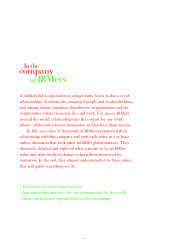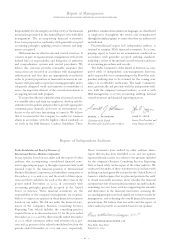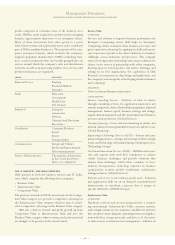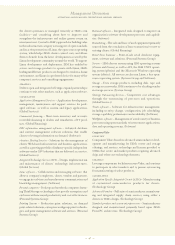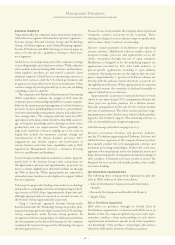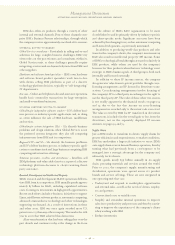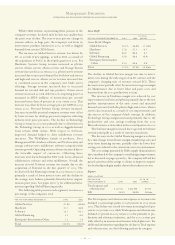IBM 2003 Annual Report Download - page 45
Download and view the complete annual report
Please find page 45 of the 2003 IBM annual report below. You can navigate through the pages in the report by either clicking on the pages listed below, or by using the keyword search tool below to find specific information within the annual report.
Management Discussion
INTERNATIONAL BUSINESS MACHINES CORPORATION AND SUBSIDIARY COMPANIES
43
road map
The financial section of the International Business
Machines Corporation (IBM) 2003 Annual Report, consist-
ing of this Management Discussion, the Consolidated
Financial Statements that follow and the related notes
thereto, comprises 81 pages of information. This Road Map
is designed to provide you with some perspective regarding
the information contained in the financial section and a few
helpful hints for reading these 81 pages.
IBM’S BUSINESS MODEL
IBM’s business model is built to support two principal goals:
helping clients become more efficient and competitive
through the use of business insight and information tech-
nology (IT) solutions; and providing long-term value to
shareholders. In support of these objectives, the business
model has been developed over time through strategic
investments in services and technologies that have the best
long-term growth and profitability prospects based on the
value they deliver to clients. In addition, IBM is committed
to its employees and the communities in which it operates.
The model is designed to allow for flexibility and periodic
rebalancing, as demonstrated with the 2002 acquisition of
PricewaterhouseCoopers’ (PwC) consulting business (PwCC),
the acquisition of Rational Software Corp. (Rational) in
2003, and the 2002 divestiture of the company’s hard disk
drive (HDD) business.
The company’s portfolio of capabilities ranges from serv-
ices that include business transformation consulting to soft-
ware, hardware, fundamental research, financing and the
component technologies used to build larger systems. These
capabilities are combined to provide business insight and
solutions in the enterprise computing space.
In terms of financial performance, over the last two years,
IBM increased its participation in the high-growth areas of
its industry, while at the same time maintaining a breadth of
capabilities that has allowed it to gain market share during
weak economic environments. In general, this strategy
results in less volatile returns overall, because each individual
capability has unique financial attributes. Some involve con-
tractual long-term cash and income streams while others
involve cyclical transaction-based sales.
In terms of marketplace performance—i.e., the ability to
deliver client value—it is important to understand that the
fundamental strength of this business model is not found in
the breadth of the portfolio alone, but in the way the com-
pany creates business solutions from among its capabilities
and relationships.
TRANSPARENCY
Transparency is a primary goal of successful financial reporting.
The following are additional improvements you will find in
this year’s Annual Report:
•The Management Discussion is designed to provide readers
with a view of the company’s results and certain factors
that may affect future prospects from the perspective of
the company’s management. A new snapshot of the key
messages in the Management Discussion has been added
on page 44 immediately following the Road Map. While
the details of the Management Discussion remain, readers
will be able to assess quickly the most important and key
drivers within this brief overview.
•The Management Discussion was redesigned to reflect
the company’s continued and improving strength in
providing broad client solutions, as opposed to a “piece
parts” conglomeration of many hardware, software and
services businesses. The Description of Business begin-
ning on page 45 (introduced in the 2002 Annual Report),
Results of Continuing Operations on page 51, Financial
Position on page 57, and Looking Forward on page 63
sections, all are now written from the perspective of the
consolidated entity. Detailed analysis for each of the com-
pany’s segments follows the consolidated perspective and
appears on pages 55 t0 57.
•Aseparate Global Financing section beginning on page 69
(introduced in the 2002 Annual Report) is retained and
not included in the consolidated perspective that is
referred to above. This section was separately retained
given its unique impact on the company’s financial condi-
tion and leverage.
•The Liquidity and Capital Resources section beginning on
page 64 was expanded to provide greater insight on the
strength and factors affecting the company’s liquidity.
HELPFUL HINTS
Organization of Information
•This Management Discussion section provides the
reader of the financial statements with a narrative on the
company’s financial results. It contains the results of
operations for each segment of the business, followed by
a description of the company’s financial position, as
well as certain employee data. It is useful to read the
Management Discussion in conjunction with note X,
“Segment Information,” on pages 117 through 121.
•Pages 74 through 79 include the Consolidated Financial
Statements. These statements provide an overview of the
company’s income and cash flow performance and its
financial position.
•The notes follow the Consolidated Financial Statements.
Among other things, the notes contain the company’s
accounting policies (pages 80 to 86), detailed information
on specific items within the financial statements, certain
contingencies and commitments (pages 101 to 103), and
the results of each IBM segment (pages 117 to 121).









